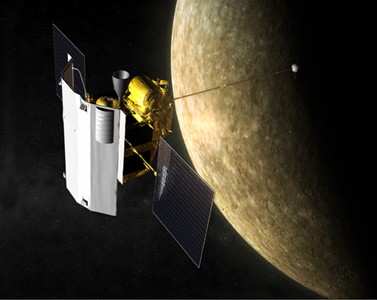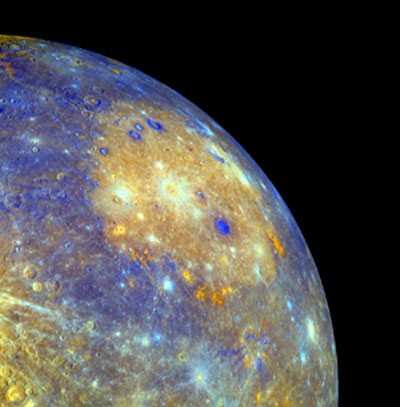Second Of Three Flybys Coming Early Next Week
A NASA spacecraft will conduct the second of three flybys of
Mercury on October 6 to photograph most of its remaining unseen
surface and collect science data.

The Mercury Surface, Space Environment, Geochemistry, and
Ranging, or MESSENGER, spacecraft will pass 125 miles above the
planet's cratered surface, taking more than 1200 pictures. The
flyby also will provide a critical gravity assist needed for the
probe to become, in March 2011, the first spacecraft to orbit
Mercury.
"The results from MESSENGER's first flyby of Mercury resolved
debates that are more than 30 years old," said Sean C. Solomon, the
mission's principal investigator from the Carnegie Institution of
Washington. "This second encounter will uncover even more
information about the planet."
During the spacecraft's first flyby on January 14, its cameras
returned images of approximately 20 percent of Mercury's
surface never before seen by space probes. Images
showed that volcanic eruptions produced many of Mercury's plains,
its magnetic field appears to be actively generated in a molten
iron core, and the planet has contracted more than previously
thought.
"This second flyby will show us a completely new area of
Mercury's surface, opposite from the side of the planet we saw
during the first," said Louise M. Prockter, instrument scientist
for the spacecraft's Mercury Dual Imaging System at the Johns
Hopkins University Applied Physics Laboratory, or APL, in Laurel,
Md.
NASA says the second flyby is expected to yield more surprises
about the unique physical processes governing Mercury's atmosphere,
as well as additional information about the charged particles
located in and around Mercury's dynamic magnetic field. An
altimeter on the spacecraft will measure the planet's topography,
allowing scientists, for the first time, to correlate
high-resolution topography measurements with high-resolution
images.
A major goal of the orbital phase of the mission is to determine
the composition of Mercury's surface. Instruments designed to make
those measurements will get another peek at Mercury during this
flyby.
"We will be able to do the first test of differences in the
chemical compositions between the two hemispheres viewed in the two
flybys," said Ralph McNutt, the mission's project scientist at APL.
"Instruments also will provide information about portions of
Mercury's surface in unprecedented detail."

The spacecraft is more than halfway through a 4.9-billion-mile
journey to enter orbit around Mercury that includes more than 15
trips around the sun. In addition to flying by Mercury, the
spacecraft flew past Earth in August 2005 and past Venus in October
2006 and June 2007.
The project is the seventh in NASA's Discovery Program of
low-cost, scientifically focused space missions. The spacecraft was
designed and built by APL. The mission also is managed and operated
by APL for NASA's Science Mission Directorate in Washington.
 Aero-TV: DeltaHawks Diesel Power Steps Into the Spotlight
Aero-TV: DeltaHawks Diesel Power Steps Into the Spotlight NTSB Prelim: Mooney Aircraft Corp. M20K
NTSB Prelim: Mooney Aircraft Corp. M20K ANN FAQ: Turn On Post Notifications
ANN FAQ: Turn On Post Notifications ANN's Daily Aero-Linx (12.20.25)
ANN's Daily Aero-Linx (12.20.25) Aero-News: Quote of the Day (12.20.25)
Aero-News: Quote of the Day (12.20.25)




